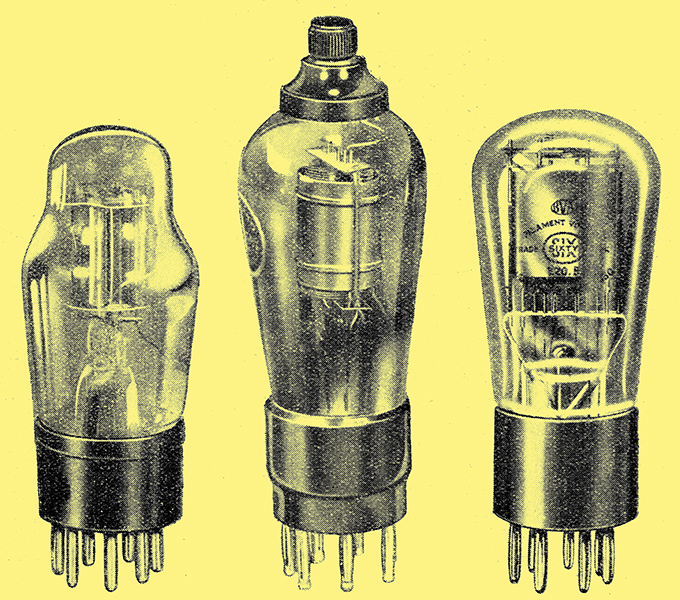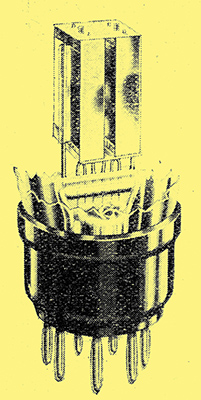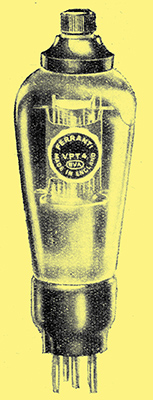|

New valves and components and new ideas in circuit design have presented the manufacturers with much wider scope for the exercise of individual ingenuity than for many years past. The superheterodyne receiver appears to have come in for the greatest amount of attention from the majority of set manufacturers; this is not surprising because the superheterodyne undoubtedly offers more scope than a straight set for making full use of the more interesting types of new valves and such circuit improvements as automatic volume control. Not that straight sets can be regarded as in any way obsolete, however, and there are some fine examples at the Show.
Valves

L-R: Marconi-Osram B21 Class B valve. - Ferranti VHT4 Heptode frequency changer. - Six-Sixty 220B Class B valve.
In past years, the multiplicity of valve types available in this country has often excited astonishment. In spite of the fact that valve manufacturers have recently dropped many of their older models, and now carry stocks of 4 Volt and 6 Volt types only for replacement purposes, there are no signs of a reduction in the number of types on the market, rather of an increase. The current year has seen a steady outpouring of new valves, and as yet the flow is undiminished.

Cossor 240B Class B valve.
The introduction of the Class B output valve is probably the greatest step forward from the point of view of the battery user, for it enables him for the first time to obtain both high quality and large volume economically. Practically every valve firm will be showing at least one type, and in spite of the fact that they fall into two general classes - those capable of giving about 1 Watt output and those rated for some 2 Watts - they show a surprising uniformity in their quiescent anode currents, which are usually between 2 mA. and 3 mA. The output load required, however, varies considerably between different valves and this point should be watched carefully when selecting a valve to work with existing apparatus. In most cases little or no grid bias is needed, but the Marconi-Osram B21 type is unusual in that it requires a negative grid bias of 3 Volts to 6 Volts.
Class B working leads naturally to the driver valve, but here we are fortunate in finding that no new type of valve is indicated; The driver is merely a new name for a particular class of triode valves, and many well known LF amplifiers have acquired a fresh dignity from their new title.
As might be expected, most of the new valves are in the AC mains range, although notable additions have been made to the DC types. Variable-μ valves are now practically universal for HF and IF amplification, whether the receiver be fitted with AVC or not. One of the chief difficulties in obtaining good AVC, however, has lain in avoiding overloading of the HF or IF valves, for some AVC systems call for a large signal input to the detector. The overload point of the tetrode valve is set largely by the negative resistance kink in its characteristic, and as this can be avoided by a pentode type construction, we shall find many examples of pentodes specially designed for HF amplification purposes, and provided with variable-μ characteristics.
Variable-μ HF pentodes will be shown on the Cossor, Micromesh, Mullard, and Six-Sixty stands, while Ferranti will have a model fitted with a 5-pin base and rated for 100 Volts screen potential. The Marconi-Osram type, however, is obtainable in two patterns - one with a 5-pin base and an internally connected suppressor grid, and the other with a 7-pin base with the additional grid brought out for external connection, thus extending the application of the valve. These firms will also be showing the first battery variable-μ HF pentode.
HF pentodes with non-variable-μ characteristics will be shown by Cossor, Marconi-Osram, Mazda, Mullard, and Six-Sixty; their chief use seems to be as detector-oscillators for superheterodyne frequency changers, although they can also be used for HF amplification and ordinary detection. Ferranti will have the first British Pentagrid frequency-changer valve on view, the type VHT4 Heptode; it is fitted with a 7-pin base and the tetrode control grid is brought out to the top of the bulb. It consists essentially of a variable-μ tetrode in conjunction with a triode oscillator, the elements being screened from one another. It is not merely two valves built into one bulb however, for the tetrode portion has no cathode in the normal sense of the word, and mixing takes place by electronic action.
Detectors
The range of detectors will be greatly increased, for in addition to the usual triodes, tetrodes, and pentodes there will be found a bewildering variety of combination diode types. The most usual is the duo-diode-triode, which is made by Ferranti, Marconi-Osram, Micromesh, Mullard, and Six-Sixty. Both Marconi-Osram and Mullard will have this valve also in DC mains form. The valve enables many new circuit arrangements to be employed, but its chief purpose is undoubtedly for providing rectification, amplification, and delayed AVC. A single-diode-tetrode will be shown by Mullard, and it is intended to replace the ordinary screen grid detector, for it has a greater input handling capacity. Cossor will have a duo-diode-pentode, consisting of a pair of diodes for providing rectification and delayed AVC, and a variable-μ pentode for the first LF stage and to which AVC bias can be applied to give simple, but practically perfect, automatic volume control. Metal rectifiers, in both single and double types, will be shown by Westinghouse, and these enable ordinary or push-pull detection and AVC to be obtained. In the output stage there will be fewer new types, but Ferranti have introduced a triode with an output of 2½ Watts at 250 Volts, and the Mullard AC044 has been redesigned to have similar characteristics. In pentodes, the well-known Marconi-Osram MPT4 is now available in the Catkin type with its output increased to 3 Watts, and there is also a new directly heated pentode with a 16 Watts anode dissipation rating. Most indirectly heated pentodes will be available in two types - one with the usual 5-pin base and a side terminal and the other with the new 7-pin base. Although it is but a short time since this base was introduced, originally for the Class B valve, many valves will now be supplied with it, including the output pentodes, Class B valves, duo-diode-triodes, duo-diode-pentodes, HF pentodes, and the Pentagrid or Heptode.
HT rectifiers have not been forgotten by the valve designers and the indirectly heated rectifier, introduced some time ago by Mazda, is now to be found in other ranges. Thus, Marconi-Osram will have the MU12 and MU14 types, equivalent to their older U12 and U14 models. The advantage of indirect heating in a rectifier, of course, is the avoidance of sudden high voltage surges which are detrimental to the life of the smoothing capacitors.
In the range of DC mains valves, few new types will be found. Mullard will have a range with heaters rated for 20 Volts at 0.18 Ampere, with the exception of the duo-diode-triode, which requires 25 Volts. The Marconi-Osram range is extended by the addition of a duo-diode-triode, and this firm has also introduced a barretter type of voltage regulator for maintaining constant heater current in DC mains sets. Cossor will have DC valves of the 16 Volts 0.25 Amperes type, including a variable-μ tetrode, a triode, and an output pentode.
As is usual with DC mains valves, these specimens are all rated for a maximum anode potential of 200 Volts.

Ferranti VPT4 screened HF pentode.
|